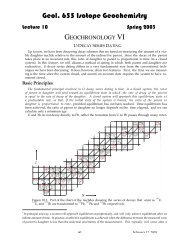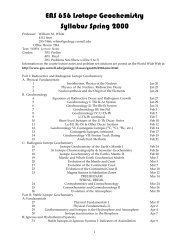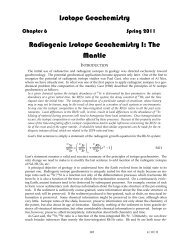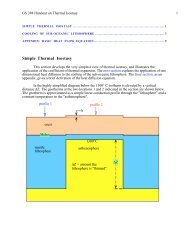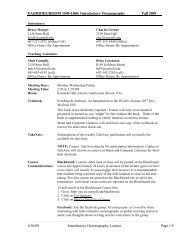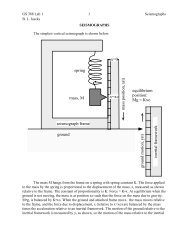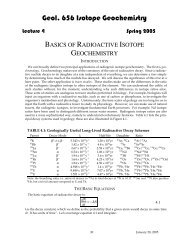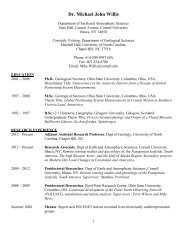Lab Handout
Lab Handout
Lab Handout
- No tags were found...
You also want an ePaper? Increase the reach of your titles
YUMPU automatically turns print PDFs into web optimized ePapers that Google loves.
Geological Sciences 101<strong>Lab</strong> #3 - Stones and Stories of the Cornell CampusINTRODUCTIONBuilding stone is rock that has been quarried, cut, and used in construction. Stones’ edges areusually sharp and faces smooth when a building is new. A stone and a building show their age byrounding of corners and roughening of surfaces. The degree of recent weathering, mineralcomposition, color and texture of many stones provide clues to the kind and source of mineralspresent in the stone; processes of ancient weathering; agents of sediment transport; physical,chemical, and biological environment of deposition; and changes that have occurred sincedeposition.The attached table provides information about some building stones on the Cornell campus. Thisworksheet and map give examples of the information available from the study of these stones, aswell as stories related to the campus. You are asked to share your discoveries, so they may beincluded in future course materials.Stop 1: Snee HallThe interior wall on the west side of Snee Hall displays two pieces of Triassic Connecticut shale.The horizontal piece shows dinosaur footprints, ganoid fish scales, possible raindrop marks, andsymmetrical ripple patterns. Note that these features are not all on the same layer within the shale.Fossil footprints are occasionally distorted and may be misinterpreted if seen on shale layers thatwere some distance below the surface when the print was made.While in the west corridor of Snee Hall be sure to look at the water flume. This clear, plastic boxcontains unconsolidated sediments, including quartz sand and darker, heavier minerals. Push thered button and adjust the slope of the flume to experiment with ripple marks.Outside Snee Hall, in the parking area, examine the south wall of Hollister Hall. This is a cementblockwall covered with a thin veneer of the local sand/siltstone. Quarrymen call this stone Llenroc(Cornell spelled backward) and it is found on many of the newer campus buildings. Llenroc can bedistinguished from Enfield and Ithaca sandstone by its orientation. Llenroc is used as a veneer, notas part of the building’s support. Llenroc is applied at 90° to its original sedimentary beddingplane. Because of this, water, salt, and plant roots can enter the thin laminations in the siltstone andsingle bedding layers may fall from the wall. This form of weathering is seen in early spring.About ten meters to the left of the stairs leading up to the Engineering Quad, at waist level, you cansee a V-shaped flute cast (a specific type of sole mark). It is about ten cm by ten cm and indicatescurrent flow across the Devonian seafloor 365 million years ago. Further to the left are smaller,cylindrical marks, more randomly oriented on the bedding plane. They are the ancient burrows ofsoft-bodied Devonian animals. Worms mostly. When a surface is extensively burrowed thesemarks are called bioturbation. Further left, at eye level, are Llenroc surfaces with shelly fossils.Finally, yet further to the left, near ground level, there are small, white dots on the Llenroc. Theseare the remains of recent ivy holdfasts. Llenroc is too fragile, too easily weathered, to allow ivycovered walls on the Engineering Quad.As you follow the service road from the Snee Hall parking area to its intersection with CollegeAve., stop to examine the kimberlite dike that crosses Cascadilla gorge just upstream from theCollege Ave. bridge. This igneous, intrusive rock cuts through the Devonian siltstones beneath1
Snee Hall. It is seen most easily in the fall just upstream from an abandoned flight of stairs that ledfrom CollegeTown to the creek.At this point you can also examine the granite curbstones. The university hopes that granite willweather less quickly than the shale and concrete curbstones found on other parts of campus.Stop 2: College Avenue BridgeThe bridge is made from blocks of Enfield sandstone, laid up for the most part with the beddingplanes in their original, horizontal orientation. The top surface of the guard rail is a good place tolook for flutes, flute casts, worm burrows, tool marks, bioturbation, and ripple marks. Can youdetermine if the ripple marks are asymmetrical (indicating a unique paleocurrent direction) orsymmetrical (indicative of to-and-fro wave action)? What structures would help you determine thata particular block is upside down (turned 180° from its original, Devonian position)?The random compass headings of worm burrows help distinguish them from sole marks, whichgive hints about ancient current direction. Some shelly fossils are also present.Stop 3: Performing Arts Center and Cascadilla HallThe Performing Arts Center opened in 1989. It is covered with Crystal Stratus marble fromVermont. Marble pieces are hung, somewhat like posters in a dorm, a short distance from thesupporting wall. Lower courses of marble show the result of freeze/thaw cycles when snowbecomes packed behind the plates. The surface of the marble provides a nice point of comparisonwith other Vermont marbles on older campus buildings.Cascadilla Hall is the oldest building on the Cornell campus. Indeed, it dates from before theopening of the university. Cascadilla was originally a water-cure sanatorium. It was acquired byEzra Cornell so he could compete for the award of federal land to finance the New York State landgrantuniversity. Other competitors in 1864 included a large brick building south of Watkins Glenand a Civil War hospital in Willard, New York. The Watkins Glen building is presently the NewYork State Fire Academy and the Willard buildings are part of a state drug treatment facility.Cascadilla Hall housed students, faculty, classrooms, dining halls, and laboratories duringCornell’s first semesters. Near neighbors included a grist mill and a hog farm. Students helpedwith road grading and construction of buildings on the Arts Quad as part of their tuition.Stop 4: The Cornell Law School, Myron Taylor HallThe present Law School was built in phases. The northern part of Myron Taylor Hall was built in1932 from Enfield Shale. An addition, on the banks of Cascadilla gorge, was constructed from thesame stone in 1988. The Devonian siltstone shows interesting color changes after almost seventyyears exposure to Ithaca weather. Would you attribute this to physical, chemical, or biologicalweathering?Above the entrance to the new part of the building is an engraved block of limestone. Theengraving reads:Cornell Law Schoolin honor ofJane M.G. Foster LL.B.’18The last line with Ms. Foster’s name, degree, and class is a separate block of stone. This stonereplaces what was, perhaps, the most expensive typo on campus. When the dedicatory limestoneblock was first carved, the degree and date read: L.L.B.’18. The proper abbreviation for the degreeof Bachelor of Law (a degree no longer awarded in the U.S., having been replaced by the J.D.) isLL.B. Because of the extra period the original limestone was recut and the new piece added. This2
limestone, and other pieces used around windows, etc., are made on many broken pieces of fossilshell. What clue does this evidence provide about the energy in the original depositional locality?Inside the new addition, low on the wall that was originally an exterior wall of the older portion ofthe building, is a nice clam fossil in cross section. The floors in the Law Library stacks are made oflarge pieces of slate, suspended at their edges on a metal frame. The interior of the library is one ofthe most impressive spots on campus.The sunken courtyard of the Law School has been used for various ceremonies, motion pictures,and plays. The wall toward College Avenue shows evidence of creep. A nice crinoid head may beseen on the limestone handrail of the western balcony.Stop 5: Uris, Olin, and KrochlibrariesThe carved heads visible on the exterior ofOlin Library (and in its interior stairwell)were originally part of Boardman Hall.Boardman served the Cornell Law Schoolfrom 1892 to 1932 and the departments ofGovernment and History from 1932 until itwas torn down in 1959. The heads werecarved locally fromCleveland sandstone.There are competing theories about themodels for and significance of these heads.Kroch Library is attached to Olin and isalmost completely underground. A specialdrainage system and pumps protect Kroch’scollections from groundwater. When thelibrary was built Devonian bedrock wasblasted. The Geological Sciences Departmentmonitored the blasts using a seismic network.Some of the rock from this site was installedat the corner of College Avenue and the SneeHall service road.Stop 6:Morrill, McGraw, and White Halls, the Ezra Cornell Statue, and the Tarr BoulderMorrill, McGraw, and White Halls were the first classroom buildings at Cornell. Morrill is namedfor the legislator who sponsored the federal Land Grant University act. Many state universitieshave a Morrill Hall somewhere on campus. These three buildings are constructed from Ithacasandstone. The quarry for this stone was just to the west on Lib slope. The slope of one quarrywall is still visible beneath the grass.The limestone surrounding the windows and trimming the stairs is extremely rich in fossils.Corals, brachiopods, clams, crinoids, and bryozoans are found easily. This stone was quarriedtwenty five miles north of campus, near the campus of Wells University. Why do these olderbuildings use local stones, while more recent additions to campus use such a variety of stone? Canyou tell where the Ithaca shale has been repaired? Can you distinguish repairs made using Enfieldsandstone from those made using cement block and Llenroc veneer?McGraw Hall was an early home of the Geology Department. Geology professor Ralph S. Tarr ismemorialized by a boulder at the corner of Morrill Hall. Tarr studied glaciers, traveled with Adm.3
Peary to Greenland in 1896, and named aglacier there after Cornell. The Tarr MemorialBoulder is anorthosite, originally fromnorthern New York. It is a glacial erraticfound on the Hart farm two miles south ofcampus. The nine-ton boulder was moved toits present location October 26, 1915. Prof.H.S. Gutsell modeled the plaque on a photoof Tarr, but left out Tarr’s often-present pipe.A metal statue of the university’s founder,Ezra Cornell, sits atop a block of Devoniangranite. Notice the telegraph instrument onwhich Cornell leans. The beginning of EzraCornell’s fortune (and the beginning ofCornell University’s endowment) rests uponhis association with Samuel Morse and theemerging telegraph industry. Cornellacquired forests of telegraph poles to stringthe wires. He was well informed about suchthings when the federal government madewestern lands available to eastern states underthe Morrill Act.Stop 7: Baker <strong>Lab</strong>, Goldwin Smith Hall, Sheldon ExedraThe Chemistry department laboratory sits on a steep-sided bluff. This is the delta built by an earlierFall Creek into a postglacial lake. Clearly the lake level was much higher than today’s CayugaLake. Notice the combination of Enfield sandstone and Llenroc used around Baker.Goldwin Smith Hall was once the home of the College of Agriculture. Notice the carvings aroundthe projecting porch seats on the building’s north wall. These are instruments used in thedetermination of butterfat content in milk. Columns on the west side of Goldwin Smith showweathering related to the direction of major winter storms and the protection provided by theoverhanging roof.At the south end of Goldwin Smith, resting atop the subterranean Kroch Library, is the SheldonExedra. An exedra is a curved bench where in classical times Greeks and Romans gathered forinformal conversations. Notice the weathering on this beautifully carved Carrara marble. Howdoes it compare with the Vermont marble seen on the Performing Arts Center?Stop 8: A.D. White House, Uris HallThe A.D. White House was the home of Cornell University’s first president. Both the exterior andthe interior are made of interesting stones. Many contain fossils. The gardens behind the house area popular spot for alumni weddings.Uris Hall (not to be confused with Uris Library) was built in 1972 from a somewhat unusual steel.This metal is an alloy of iron, manganese, copper, nickel, and chromium. It was designed tocombine with sulfur in the atmosphere and produce a tough, tightly-bonded layer of iron oxide(rust). The rusty layer was intended as a substitute for paint on the building’s exterior. Any smallscratch paints itself over automatically. It was not intended for the rusty layer to be quite so watersolubleand paint the surrounding concrete.4
Uris Hall contains the famous Cornell Brain Collection. Several of the more interesting humanbrains are on display outside of Room 211, the offices of the Psychology department.Stop 9: Sage HallSage College was Cornell’s first home for women students. In 1998 it underwent extensiverenovation to become the home for the Johnson Graduate School of Management. The olderportion of the building is chiefly of brick; the renovations used many colored stones from Canadaand Brazil. All of this stone was shipped to Carrara, Italy to be cut to size, before being shipped toIthaca for installation.Notice how the old bricks have been repaired and the weathered mortar replaced.5
SOME OTHER PLACES ON CAMPUS:Mann Library:Look for fossil snails and clams in cross section in the gray siltstone walls of the entry foyer.There is an especially nice snail shell at about eye level to the left of the door leading from the smallfoyer into the larger lobby.Also watch for the stylolites that crisscross the somewhat metamorphic limestones and marblesused as floors, stairs, and bathroom walls on the Ag Quad. These structures are named for theirjagged, pointed (like a stylus) shape. They remind some people of a row of sharp teeth or therecord of an earthquake. Stylolites form when some minerals in limestone dissolve under pressure.A jagged surface of the darker, less soluble minerals is left behind. The stylolite surface (seen incross section as a jagged line) is at right angles to the applied stress.Morrison Hall:The entry foyer is one of the best on campus. Note how the red granite of the exterior gives way toa softer, reddish limestone on the interior. The limestone is rich in fossil crinoids. Look for thefive-pointed stars at the center of the crinoid stems. This feature is the hallmark of theechinoderms.Also examine the horse head in Vermont marble by E. Abbe.Cornell Plantations:Look for Devonian fossils in the shales and siltstones of the Herb Garden by the PlantationsHeadquarters building.Federal Nutrition <strong>Lab</strong>oratory:A very nice pegmatitic granite used as the front doorstep has wonderful crystals.Campus bathrooms:In general, architects put some of their nicest stones on bathroom walls. Take a closer look.The Uris Hall--Statler Inn Bollard:Bollard is a nautical term for the short pillar on a dock to which ships tie their lines. An interestingred pillar between Uris Hall and Statler Inn is used to block vehicular traffic on a pedestrian path.This stone is a syenite. It looks like granite and, like granite, contains feldspar and mica. Unlikegranite, syenite has no quartz.NOTES:6
QUESTIONS1) How do you distinguish a siltstone from a shale?2) How does a flute or flute cast allow you to interpret the paleocurrent--the direction that waterwas flowing when the original sediments were deposited?3) Find and record a campus location showing delamination of Llenroc.4) Select a campus bathroom, record its location, and survey its stones. Are the stones in thebathroom similar to other stones used in the building?5) What is the minimum number of dinosaurs needed to produce the tracks seen on the large,horizontal slab in the ground floor corridor of Snee Hall?6) Which stone records a high energy environment of deposition (that is rough water as opposedto calm): Enfield shale or Onondaga limestone? Cite evidence for your conclusion.7) Marble is a metamorphic form of limestone. One “age” of a marble is the time the limestone wasdeposited. Another possible “age” is the time the limestone was changed to marble. If fossils canbe recognized in the marble, from which “age” are they?8) Locate one of the three Triassic marbles and one of the four Ordovician marbles on campus.Compare and contrast the two stones.9) Is the kimberlite dike in Cascadilla gorge older or younger than the Devonian bedrock that itintrudes?10) Many campus buildings are made of brick or concrete, which are essentially artificial rocks.What stone is brick most similar to? What stone does concrete most closely resemble?11) There are no campus building stones identified from the Cretaceous or Permian periods. Theend of both these periods is marked by a major biologic extinction event. Do you suppose thatthere is a relationship between the extinction event and the lack of building stone? Why/why not?12) Imagine a stream like the ancient river that drained the Devonian Acadian mountains. It carriesa variety of things as it flows downhill--dirt, rocks, dead bugs, leaves etc. Think about thedeposition of the particles carried downstream, and also about the dissolved materials transportedby water--salt and other soluble minerals. Make a sketch showing specifically where sand-sizedparticles are found, where silt-sized particles are found, where clay-sized particles (the smallest)are found, and where soluble minerals will be found.13) Do you think that stone weathers more quickly in its original location in a natural outcrop or inits new location as part of a campus building? Explain.7





